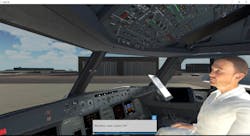Virtual Reality, Augmented Reality, and Plain Old Reality for Maintenance Training
Bill Johnson talks about a recent Aviation Training Summit and the current and emerging technologies available for maintenance training. The article also blends the promise of training technology, the impact on maintenance staff shortages, and how government and industry can positively influence acceptance.
In the June/July 2018 AMT issue, I wrote about “Another Look at the Aviation Maintenance Shortage and the Solutions.” That issue was dedicated to training and personnel issues. It is worth revisiting that issue at (aviationpros.com). I made many action recommendations for schools, industry, and government. I suggested that schools should: modernize training technology; reinforce partnerships with industry; propose new alternative curricula; and ensure recurrent training for instructors. I suggested that industry should: Collaborate with schools and help schools with equipment. Government should: recognize the urgency, consider all reasonable proposed curricular modifications, and stay the current positive course for change. That is plain reality! Now let’s look at the other realities that include virtual, augmented, and other computer-based training.
Attend a Training Conference
Modern training conferences can be a delight for maintenance training personnel. Among others, Halldale Publishing specializes in training conferences. They offer five aviation training conferences, around the world, each year. The big one is the Spring World Aviation Training Summit (aka, WATS), always in Orlando. These conferences are great for training professionals. Speakers actually talk about aviation training system design, job and task analysis, media design and selection, competency-based instruction, student evaluation, instructor selection and qualification, training regulations, and more. The meetings assemble the best selection of aviation training materials, from books to the highest technology-based training devices. In August, I attended and spoke at the Asia-Pacific Aviation Training Symposium (APATS). That is the primary basis for this article.
Virtual Reality
Training conference presenters have been talking about the terms virtual reality (VR) and augmented reality (AR) for a long time, more than a decade. The presenters were often college research professors, engineers from commercial labs, or training system developers from the large airframe manufacturers. They often spoke about the developments for the Department of Defense, or for other well-heeled organizations, that conduct high volume training that justifies significant financial investment. Of course, there can be high return on training technology investment when there are many students or when the use of real equipment is simply not feasible. Conference presenters would often show pieces of the VR/AR technology but few were fully developed and in daily use. Today the demonstrations are fully completed and used daily throughout the industry. VR is “for real” in selected aviation maintenance training applications.
Simply defined, VR is like the real world (reality). It is “almost” like the real world, thus the term virtual. That means VR offers a multi-dimensional view that makes our senses believe we are seeing the real thing. That definition could include the baby boomers’ toys, like the “View Master,” to the modern day affordable, toy-like, headsets, to large rooms with VR displays. The VR air traffic control towers or 360-degree domes for flight simulators are large room examples.
VR does not have to be completely immersive in a virtually real-world environment. Aviation maintenance VR permits users, right from a computer screen, to walk around or into an aircraft, to open the cowlings, to perform many line check activities, or even delve into the internal workings of any system. Commercial airframers have the very best VR systems for use in the factory-training courses. Figure 1 shows an example for A 350 Airbus training. Such systems are applicable to individual solo students or can supplement classroom instruction. Currently, most new airliners VR will be at your fingertips. Alternatively, convince the manufacturers to accommodate some of your technical trainers for instructor recurrent training. That is an example of industry-school collaboration.
Spartan College of Aeronautics and Technology has developed its own version of VR with a virtual Cessna 182. It has over 6,000 photographs, with additional graphics and videos to depict many common C-182 maintenance tasks. Figure 2 shows examples of a scaled back VR system from Spartan.
Appropriate instructional system design must guide the required level of VR. That is true whether it is for small aircraft maintenance training, a large turbine engine teardown, or an A380 line maintenance check. Extremely sophisticated, fully immersive, VR is likely necessary for high sales volume commercial games. Relatively low volume maintenance training likely requires a lower level of VR. Some apply the term “mixed reality” to combine traditional computer-based training with varying levels of VR. Again, this is dependent on learning analysis.
Augmented Reality
Augmented reality (AR) is a form of VR that uses either the real world or pictures/video of the real world with an overlay of digital information. Figure 3 shows a type of AR message overlaid on a VR screen. Aircraft or automotive windshields, with projected “heads-up” digital messages is AR.
For another common example, a user may wear a pair of glasses with a built-in screen. In actual maintenance, or for maintenance training, a user can ask for or automatically receive appropriate information. Another AR delivery method can be as simple as using a handheld device to obtain maintenance instruction. See Figure 4 for telephone-based AR example. It is likely that the evolution of the AR display and associated data technologies will enhance the use and the culture of following technical procedures.
The Plain Old Reality
I drummed up this term, not only to create a catchy title but also to refer to the real world of maintenance training. Currently, most VR is expensive to create and modify. It is cost prohibitive to most training organizations. That is especially true for the institutions that are delivering initial training for maintenance certification. All trends indicate that the development and delivery cost will go down.
AR has its own set of challenges. The wearable technologies are delicate for daily maintenance use. Some users complain about the distraction of the visual display. Development and support costs are high. Again, evolving technology will overcome the challenges.
Influencing Factors on Training Technology and Its Impact
National aviation authorities can have a significant positive impact on the growth of VR and other simulation training technologies. Research has shown that the pace of learning and knowledge/skill retention improves with active learning activities. New training technologies ensure active learning. Regulators must be increasingly willing to accept the curricula change and increased learner competence that VR and other technology can provide. Regulations must continue to match instructional technologies and modern generational learning styles. That match will help promote the mass market for VR, AR, MR, and other technologies. A growing marketplace will drive increased capability at lower cost. A result is an increased number of qualified and safe maintenance personnel.
The aviation industry can play a more active role in advancing the use of VR in schools. Manufacturers could make selected intellectual property and equipment more available to schools. That is not a suggestion for industry to school charity. Instead, it is commercial recognition that the current maintenance personnel qualifying system is not working as well as it could. The entire international aviation industry is running out of qualified workers. It is clearly an advantage, to everyone, if newly certified mechanics/maintenance engineers are familiar with modern aircraft systems and maintenance procedures. New modern training systems will help attract today’s students and ensure a higher number of graduates that are ready to work. The collaboration between industry and schools is imperative as the world faces a certain shortage of qualified maintenance personnel.
The Bottom Line
As I participated in the Asia Pacific Aviation Training Symposium, it dawned on me that the justifications for advanced technology training have been consistent and true for decades. Training technology evolves as an enhanced substitute for the real equipment and the real world. Compared to live equipment simulation and computer-based training, including VR and AR, VR is the better alternative. It wins on comparisons of cost, speed, effectiveness, availability, reliability, learner safety, and more. I feel confident in that positive trend.
About the Author

Dr. Bill Johnson
Chief Scientific and Technical Advisor Human Factors in Aviation Maintenance, FAA
““Dr. Bill” Johnson is a familiar name and face to many industry and government aviation audiences. Johnson has been an aviator for over 50 years. He is a pilot, mechanic, scientist/engineer, college professor, and senior executive during his career. That includes 16+ years as the FAA Chief Scientific and Technical Advisor for Human Factors.
Dr. Bill has delivered more than 400 Human Factors speeches and classes in over 50 countries. He has 500 + publications, videos, and other media that serve as the basis for human factors training throughout the world.
Recent significant awards include: The FAA “Charles E. Taylor Master Mechanic” (2020); The Flight Safety Foundation - Airbus “Human Factors in Aviation Safety Award” (2018), and the International Federation of Airworthiness “Sir Francis Whittle Award” (2017).
Starting in 2021 Johnson formed Drbillj.com LLC. In this new venture he continues to bring decades of human factors experience to aviators, worldwide.
